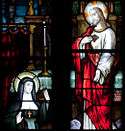Shrine of the Virgin of the Rosary of Pompei
| Pontifical Shrine of the Blessed Virgin of the Rosary of Pompei Pontificio Santuario della Beata Vergine del Santo Rosario di Pompei | |
|---|---|
|
The shrine dedicated to the Blessed Virgin Mary | |
| Basic information | |
| Location | Pompei, Italy |
| Geographic coordinates | 40°45′0″N 14°30′2″E / 40.75000°N 14.50056°ECoordinates: 40°45′0″N 14°30′2″E / 40.75000°N 14.50056°E |
| Affiliation | Roman Catholic |
| Province | Territorial Prelature of Pompei[1] |
| Year consecrated | 1901 |
| Ecclesiastical or organizational status | Cathedral, minor basilica, shrine |
| Leadership | Mons. Carlo Liberati [1] |
| Website |
www |
| Architectural description | |
| Architect(s) | Antonio Cua , Spirito Maria Chiappetta |
| Architectural type | Church |
| Groundbreaking | 1876 |
| Completed | 1901 |
| Specifications | |
| Direction of façade | S |
| Capacity | 6000 [2] |
| Length | 95 m (312 ft) |
| Width | 55 metres (180 ft) |
| Width (nave) | 30 m (98 ft) |
| Height (max) | 57 m (187 ft)[2] |
| Materials | Masonry, reinforced concrete |
The Pontifical Shrine of the Blessed Virgin of the Rosary of Pompei (Italian: Pontificio Santuario della Beata Vergine del Santo Rosario di Pompei) is a Roman Catholic cathedral, Marian pontifical shrine and minor basilica commissioned by Bartolo Longo, located in Pompei, Italy. It is the see of the Territorial Prelature of Pompei.
History
Bartolo Longo started restoring a church in disrepair in October 1873 and promoted a festival in honor of Our Lady of the Rosary.[3] In 1875, Longo obtained a painting of Our Lady of the Rosary from a convent in Naples and raised funds to restore the image so as to locate it in the church. Miracles began to be reported and pilgrims began flocking in droves to the church. Three hundred people of the area pledged a penny a month for the work.[3] Bartolo Longo was encouraged by Giuseppe Formisano, Bishop of Nola, to begin the construction of a larger church—the cornerstone being laid on the 8 May 1876. The church was consecrated on the 7 May 1891 by Cardinal Raffaele Monaco La Valletta, representing Pope Leo XIII.
Pope Benedict XVI presented his sixth Golden Rose to the shrine on the 19 October 2008.[4]
Architecture
The original building built between 1876 and 1891 and designed by Antonio Cua followed a Latin cross plan. It was only 420 square metres (4,500 sq ft).[5] The construction of the façade, work of Giovanni Rispoli, started on the 15 May 1893. The facade culminates with the statue of the Virgin of the Rosary (18,000 kg (40,000 lb), 3.25 m (10.7 ft)),[2] work of Gaetano Chiaromonte, carved from a single block of Carrara marble, beneath which are placed the word "PAX" and the year "MCMI" (1901).
To accommodate the increasing numbers of pilgrims, the sanctuary was expanded between 1934 and 1939 from one to three aisles, keeping its Latin cross plan. The project was designed by the architect-priest Monsignor Spirito Maria Chiapetta.[2] Each new aisle has three altars on each side. The new building with its 2,000 square metres (22,000 sq ft)[5] can accommodate up to 6,000 people.[2]
The 80-metre (260 ft) bell tower built between 1912 and 1925 was designed by Aristide Leonori, assisted by his brother Pio Leonori.
Our Lady of the Rosary
The painting of "Our Lady of the Rosary" with its bronze gilt frame is presented to the pilgrims on the high altar. The venerated painting depicts the Virgin Mary and Child Jesus presenting rosaries to Saint Dominic and Saint Catherine of Siena. Originally bought by Dominican priest Alberto Radente for eight carlini in Naples,[6] it was offered to Bartolo Longo on the 13 November 1875 for the church he was building in Pompei.
An attempt was made by an amateur to restore it, and it was placed in the church on 13 February 1876, the foundation day for the Confraternity of the Holy Rosary there. In 1880 the famous Italian painter, Federico Madlarelli, offered to restore the image. It was again finally restored by Vatican artists in 1965.[3]
See also
Notes
- Citations
- 1 2 "Territorial Prelature of Pompei". GCatholic.org. Retrieved 21 July 2011.
- 1 2 3 4 5 Official website
- 1 2 3 Frisk, M. Jean. "Our Lady of Pompeii", Marian Library, University of Dayton
- ↑ Pastoral Visit to the Pontifical Shrine of Pompeii
- 1 2 Carillo, Sepe & Petillo 2010, p. 802
- ↑ Cruz 1984, pp. 88–89
- Bibliography
- Cruz, Joan Carroll (1984). Relics. Huntington, Ind.: Our Sunday Visitor. ISBN 978-0-87973-701-6. Retrieved 21 July 2011.
- Carillo, Saverio; Sepe, Vincenzo; Petillo, Pasquale (2010). "The Huge Enlargement with R.C. Structure of the Shrine of Pompeii in Italy (1933-1939): a Technological, Architectonic and Cultural Challenge" (PDF). IABSE Symposium, Large Structures and Infrastructures for Environmentally Constrained and Urbanised Areas (Conference paper). Venice: 802–809. Retrieved 23 July 2011.
External links
| Wikimedia Commons has media related to Beata Vergine del Rosario (Pompei). |

